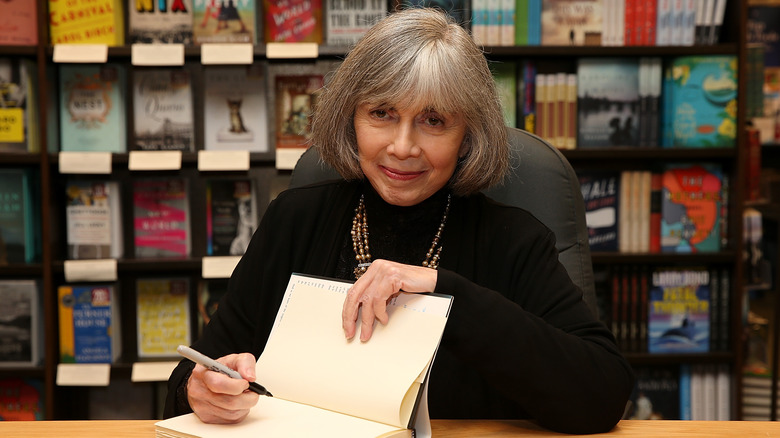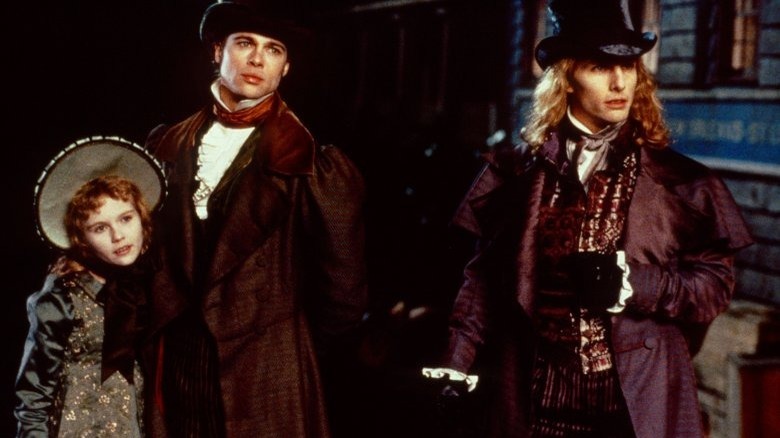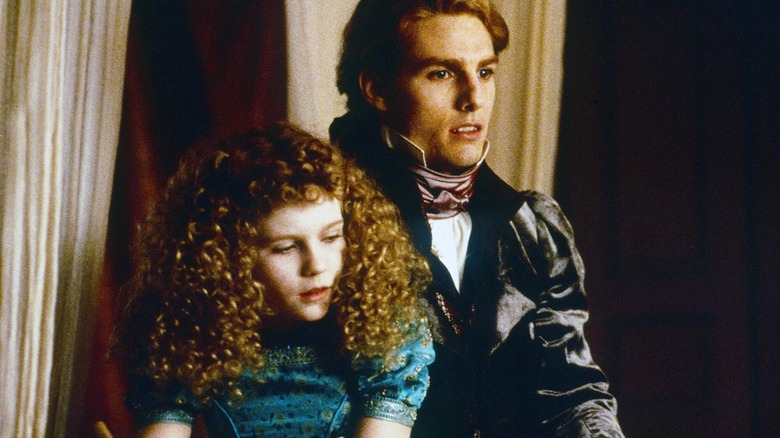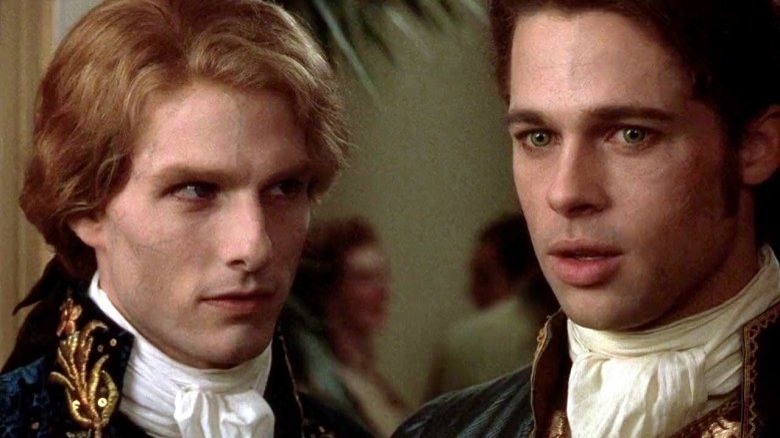The Legacy Of Anne Rice, The Modern-Day Queen Of The Vampires
On December 11, 2021, author Anne Rice passed away at the age of 80. The bestselling writer behind the "Vampire Chronicles," Rice's legacy as one of the 20th century's most influential and iconic writers has long been secured. With over 150 million book sales to her name, we have Rice to thank for our modern-day understanding and tastes for vampire fiction. It's easy to argue that she did more to influence how we perceive vampirism in pop culture than anyone living or (un)dead aside from Dracula's own Bram Stoker. If you've read any vampire novel of the past four or so decades then it was more than likely inspired, influenced by, or thoroughly embedded within the conventions pioneered by Anne Rice.
Rice was born Howard Allen Frances O'Brien in 1941 but changed her name to Anne on her first day of school because being a little girl called Howard presented its fair share of challenges. As an adult, she moved to San Francisco and took night courses at the city's main university. She married Stan Rice, a poet whom she met as a high schooler, when she was just 20. In 1966, her daughter Michele was born, but she passed away at the age of five from acute granulocytic leukemia. While still mourning the loss of her daughter, Rice began working on her first book, which would later evolve into "Interview with the Vampire." It took her five weeks to complete the 338-page novel, and she eventually earned a $12,000 advance for the hardcover rights at a time when most debut authors received perhaps $2,000 at best. Critics were mixed but the sales spoke for themselves. It didn't take long for "Interview with the Vampire" to find its people and it's easy to see why.
I've re-read "Interview with the Vampire" several times over my life, and it always feels startlingly fresh whenever I pick it up. In 1976, it must have seemed radical, especially in comparison to contemporary vampire fiction of the time. The Hammer Horror franchise was spluttering towards an undignified ending, well beyond a parody of its former self. Science-fiction writers like Richard Matheson had turned vampires into violent figures of abject fear, more rooted in the speculative than the gothic. Rice's vampires are baroque, intensely emotional, deeply humane, and unabashedly queer.
The Vampire Lestat and LGBTQ+ Allyship
As the title suggests, "Interview with the Vampire" is written as an exceedingly long and detailed conversation between a human journalist and a vampire named Louis de Pointe du Lac, the latter of whom wants to recount his long and storied life as a cautionary tale of sorts. Over 200 years, Louis has evolved from a grieving plantation owner to perhaps the most emotionally tortured vampire who has ever lived. He struggles with losing his innate humanity thanks to his newfound thirst for blood, and he is contrasted with his master/companion/bratty boyfriend Lestat de Lioncourt, a French nobleman who eagerly slaughters humans and laughs in the face of his frenemy's emotions.
It may have been Louis' story that kickstarted Rice's vampiric reign, but it was Lestat who became her brat prince. Nine years after "Interview," she published a sequel, "The Vampire Lestat," wherein he grabbed the reins of the narrative and told his own origin story, all to the backdrop of his new life in the 1980s as a world-famous rockstar. It is Lestat who laid the road for the modern vampire archetype: arch, dramatic, philosophical, sexual, simultaneously hugely entertained and traumatized by his own immortality. He can be truly monstrous but still contains an immense capacity for love beyond boundaries of gender and sexuality.
Indeed, it is that fluid approach to such topics that helped to make Rice an LGBTQ+ icon. All of Rice's vampires are canonically bisexual, with queer sensuality depicted in a romantic yet matter-of-fact manner that must have felt incredibly exciting in the midst of the '80s (Rice has also talked about her vampires as existing in a world before the AIDS epidemic.) Lestat has several lovers throughout the series, most of whom are men. In "The Vampire Lestat," when he turns his mother Gabrielle into a vampire, she immediately cuts off her hair, begins wearing masculine clothing, and abandons all markers of femininity in favor of a life free of gendered constraints. For queer readers, the image of the vampire that Rice presents, that of a lost soul on the outside of societal restraints who is able to love and life freely, was immediately appealing. Rice spent many years supporting LGBTQ+ causes. After her death, the filmmaker Phaylen Fairchild detailed her experiences with Rice, including her "fabulous" reaction to Fairchild coming out as a trans woman. "She told me at the time that she believed transgender people were sacred," Fairchild said. "That we possessed a unique gift of life experience that few ever would, which would allow us to see the world from 'A view from the greatest height.'" Rice herself talked about often feeling as though she did not have a gender, and millions of people found hope in her words, more so today, when rampant transphobia has seeped its way into the cultural mainstream.
No Winks or Nods
Rice didn't just write vampires either. She wrote about a multi-generational clan of matriarchal witches haunted by an evil demon. She created maybe the first metaphysical crime series, featuring an assassin who becomes a time traveling detective for angels. She pioneered a highly literary and wonderfully explicit series of erotica that remains vibrant and transgressive decades after its publication. When she became a born-again Christian, she wrote historical novels about Jesus Christ's youth (she later left the church over its anti-LGBTQ+ stances.)
And she took all of these worlds 100% seriously. There are no winks or nods in her vampire novels, no puncturing of the all-consuming melodrama that takes on life and death magnitudes under her penmanship. Nobody loved their own characters so fervently as Rice, nobody believed in their potential to change the world as heavily as she did. Even as her stories got increasingly ambitious and occasionally ludicrous over 15 novels (spoiler: aliens turn up at one point), you never doubted Rice's stalwart commitment to her creation. To Rice, vampires could be so much more than a mere creature of the night. Still, her work was not without its problems, including some issues with Louis' past as an owner of slaves and some uncomfortable moments regarding sexuality and underage people.
Where Are the Anne Rice Adaptations?
There have been surprisingly few adaptations of Rice's work. The 1994 big-screen version of "Interview with the Vampire" is a sumptuous and mostly faithful rendition of her debut that captured Rice's feverish intensity. Rice had initially protested the casting of Tom Cruise as Lestat but later admitted that he was ideal for the part. What director Neil Jordan understood about the novel is how full-throated it is in its commitment to telling a serious story. Much like Rice's work, the film is lavish in its love for these vampires, even the most despicable among them. None of her old-school gothic prose has been watered down or reduced to cheap jokes. While the film makes some major changes and is sadly not as open in its homoeroticism as the books, the core of Rice's intent is fully intact. There's something kind of miraculous about seeing a story like this be treated with such reverence, starring the biggest hunks of the era in a romantic drama made for the biggest audience possible. Sadly, it's a one-off in Rice adaptation history, and we never got to see this team make the follow-up (consider the alternate history where Tom Cruise makes "The Vampire Lestat" instead of "Mission: Impossible.")
A rushed-out and deeply condensed take on "Queen of the Damned" was released several years later with a new cast, a total whitewashing of the material's queerness, and a lot of music by Korn. It didn't do well, and neither did a Broadway musical adaptation with songs by Elton John. A long-awaited television series of the "Vampire Chronicles" is in the works for AMC, which Rice and her son Christopher had been heavily involved with. It's a shame that she never got to see the end results of her many years of development.
Vampires never truly die. They appear and reappear with reliable regularity in the ceaseless cycles of entertainment trends. Anne Rice's vampires, in particular, are immortal in our cultural consciousness. There will always be a need for stories of lost souls who explore power and desire beyond the smothering confines of society's demands. Rice understood that with such passion and clarity. For every lonely kid who feels like nobody gets them, Anne Rice's books will be there to help. Other vampires may come and go, from the sparkly to the parasitic, but Lestat and company will outlive them all.



